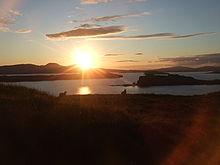Þórkell Þórmóðarson
The saga relates that in about the year 1230, a Norwegian-Hebridean fleet sailed down through the Hebrides, where it attacked certain islands there, and proceeded on to the Isle of Man.When it approached the Isle of Lewis, a man named Þórmóðr Þórkelson fled for his life, leaving behind his wife and possessions to be taken by the marauding fleet.One of the noted members of the fleet was Óláfr Guðrøðarson, King of Mann and the Isles, who is known to have been at odds with his nephew, Guðrøðr Rögnvaldsson.One theory, put forward in the 19th century, asserts that Þórkell and Þórmóðr, had backed the side of Guðrøðr, and were killed by adherents of Óláfr.According to twentieth-century historian Alan Orr Anderson, although the Eirspennill version may be of a later date than the others, it is the most authoritative, and likely represents an early form of the saga.[9] If the saga accounts are to be believed, the fleet totalled eighty ships, and according to historian Richard Oram, this likely equates to a force of over three thousand men.When Balki 'the Young' Pálsson, and Óttarr Snækollr, heard of this, they sailed south to Skye,[note 2] where they came upon Þórkell Þórmóðarson at Vestrajǫrðr, where they fought him.[12] After the death of Þórkell, the whole fleet sailed to the Sound of Islay, and was further strengthened by Hebrideans and grew to a size of eighty ships.The Norwegians left in the Spring, and sailed north to Kintyre; here they encountered a strong force of Scots and both sides lost many men during the ensuing battle.Writing in 1871 of the history and traditions of Skye, Alexander Cameron noted the events surrounding Þórkell at Vestrajǫrðr, and stated that the location refers to Loch Bracadale.[22] Thomas considered that Þórmóðr Þórkelsson was the surviving son of Þórkell;[20] later at the beginning of the 20th century, historian William C. Mackenzie was of the same opinion.[19] W.C. Mackenzie noted that not long after the fleet forced Þórmóðr from Lewis, Guðrøðr took revenge on Páll, who had mutilated him years before.[28][29] Thomas believed that the eponymous ancestor of the clan was Ljótólfr, a character in the mediaeval Orkneyinga saga,[25][30] which depicts him as a 12th-century nobleman from Lewis.




Isle of SkyeHákonar saga Hákonarsonarpatronymkings' sagaHebridesIsle of ManLoch BracadaleLoch DunveganLoch SnizortIsle of LewisÓláfr GuðrøðarsonKing of Mann and the IslesGuðrøðr RögnvaldssonLjótólfrOrkneyinga sagaClan MacLeodMacLeodSìol ThorcaillMacNicolsSturla Þórðarsonoral traditionsEirspennillFlateyjarbókSkálholtsbókAlan Orr AndersonKingdom of Mann and the IslesGuðrøðr ÓláfssonSomairleLord of ArgyllInner HebridesÓláfrillegitimateRögnvaldrGuðrøðrcastratedLord of Gallowayhis illegitimate sonThomasEarl of AthollHákon HákonarsonKing of NorwayÓspakrG.W.S. BarrowArgyllKintyreRichard OramFirth of ClydeIsle of ButeassemblyHákonBergenOrkneyPáll BálkasonSound of Islaythe castleSpringNorwayOld NorsehistorianAlexander MacKenziepromontoryArgyllshireantiquarianF.W.L ThomasApplecrossGairlochPeter Andreas MunchsheriffmutilatedScottish Gaelic namesTormodTorcallLate Middle Agesseated on the shoresnoblemandistaffgenerationflourishedAssyntTorquil MacLeodDubgall mac SomairlePictishGaelicdiminutive suffixEncyclopedia.comOxford University PressSellar, W. David H.InvernessEdinburghAnderson, Alan OrrBarrow, G.W.S.University of Toronto PressOram, RichardCambridge University PressLeidenHanks, PatrickMackenzie, AlexanderPaisleyFour Courts PressMoore, Arthur WilliamLondonMunch, Peter AndreasChristianiaDouglas, Isle of ManSellar, W. David. H.Cowan, Edward J.East LintonEdinburgh University PressThomas, F.W.L.Proceedings of the Society of Antiquaries of ScotlandCopenhagenVigfusson, GudbrandHer Majesty's Stationery OfficeEyre and SpottiswoodeClan MacLeod of Harris and DunveganClan MacLeod of LewisMacLeod of Harris and Dunvegan(MacLeod of MacLeod)MalcolmIain CiarWilliam CleireachIain BorbWilliam DubhAlasdair CrotachSir Rory MorNormanJohn Norman